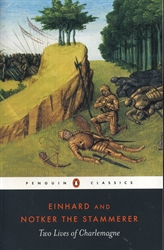

We may think, therefore, of the Monk’s narrative as being separated from that of Eginhard by more than sixty years, and by about seventy from the death of its hero. when he stayed for three days at the Monastery of Saint Gall, and it is possible to fix this event, with precision, to the year 883. The work was suggested to him, he tells us, by Charles III.

An incident mentioned by the Monk of Saint Gall makes the task of dating his work within limits an easier one.

It is impossible to fix with any certainty the date of the composition of Eginhard’s life, but there are various indications which make 820 a not impossible date. And yet the two narratives were divided from one another by no long interval of time.

The restrained, positive, well-arranged narrative of Eginhard seems to belong to a different age from the garrulous, credulous, and hopelessly jumbled story of the Monk of Saint Gall. Professor Bury remarked in his inaugural lecture at Cambridge: “It would be a most fruitful investigation to trace from the earliest ages the history of public opinion in regard to the meaning of falsehood and the obligation of veracity” and these two lives would form an interesting text for the illustration of such a treatise. It is not merely the value which each in its different way possesses, but also the great contrast between them, that makes it seem useful to present them together in a single volume. This volume contains two lives of Charles the Great, or Charlemagne (for both forms of the name will be used indifferently in this introduction) both written within a century after his death both full of admiration for the hero of whom they treat both written by ecclesiastics but resembling one another in hardly any other particular.


 0 kommentar(er)
0 kommentar(er)
